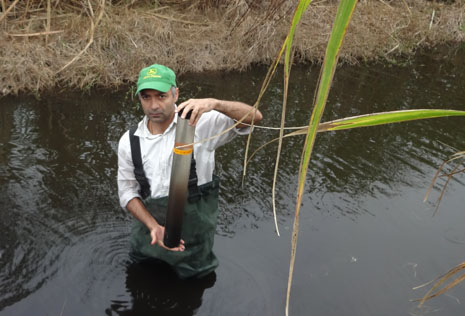Dr. Jehangir "Jango" H. Bhadha
Assistant Professor, Soil and Water Sciences
Specialty: Soil, water, and nutrient management
Soil sustainability, Water conservation and Nutrient management are the cornerstone of Sustainable Agriculture. My research program focuses on promoting sustainable agricultural practices in and around the Everglades Agricultural Area (EAA). One of the major concerns in the EAA is soil loss due to oxidation, locally referred to as “soil subsidence”. My goal is to identify agricultural options such as crop rotation and biochar that can add years to the productive life of a farmland. Farming practices have long been mindful of nutrient management as it relates to sufficiency and efficiency of nutrient utilization. My research program also explores the use of locally derived organic feedstocks and aquatic vegetation as an alternative source of slow release fertilizer when applied on depleted soils.
Program Areas
- Using submerged aquatic vegetation as biofilters to reduce phosphorus loading
A promising innovative treatment technology that has not yet been evaluated within the EAA is the approach that utilizes aquatic vegetation in conjunction with the calcium saturated surface waters to remove P from the water column. This will be achieved by circulating high P concentration farm canal water through the ditches prior to being discharged off site. Optimizing the flow through the ditches will allow the submerged aquatic vegetation (SAV) to uptake P. The vegetation will ultimately be harvested and incorporated back on to the fields. The removal of nutrients like phosphorus (P), nitrogen (N) and carbon (C) is accomplished by plant uptake. In addition to P-uptake by plants, adsorption to (or co-precipitation with) calcium carbonate could also result in the water column. As part of this demonstration study, submerged aquatic plants like Chara and Southern naiad will be introduced in farm ditches, and the flow of water through the ditches will be controlled using solar-powered, battery operated pumps. Chara is a genus of blue-green algae in the family Characeae. They are found in fresh water, particularly in limestone areas, where they grow submerged, attached to the muddy bottom. They are native to Florida and are most suited to shallow, hard water, typical of farm canal waters in the EAA.The goal of this project is to demonstrate that EAA on-farm nutrient load reduction can be achieved through the use of solar-powered water pumps that circulate farm canal water through SAV-seeded field ditches at optimum flows that provide sufficient residence time for nutrient removal. In addition to uptake by aquatic vegetation, P removal from farm canal waters will occur via P co-precipitation with calcium carbonate. The presence of limestone caprock beneath the EAA fields and canals provides calcium saturated surface waters that can co-precipitate P from the water column with calcium carbonate during photosynthesis-induced pH elevations. We also anticipate a drop in dissolved organic carbon (DOC) concentration as part of the treatment demonstration. This is due to the fact that the SAV will fix a portion of the DOC as it establishes its growth; in addition to high photolytic activity associated with shallow ditch water.
- Environmental and cultural benefits of growing flooded rice
During the summer months, more than 50,000 acres of fallow sugarcane land is available for rice production. In 2015, nearly 23,000 acres of rice were planted in the EAA, yielding approximately one million hundred weights (cwt) of harvested green rice. The net value of growing rice as a rotation crop exceeds its monetary return. Production of flooded rice in the EAA provides several benefits to the agroecosystem. Growers greatly reduce soil subsidence, nutrient depletion, and insect pests by flooding fields. Production inputs like silicon, used to boost rice yields, has a carryover benefit on the subsequent sugarcane crop. One of the major concerns in the EAA is soil loss dues to oxidation, locally referred to as “soil subsidence.” Soil subsidence is the loss of top soils due to decomposition (mineralization) of organic matter. In the presence of oxygen (air) microbial activity facilitates organic matter mineralization.Typically, deep water table and high temperatures tend to aerate the top soil, which in turn accelerates mineralization. Growing flooded rice provides anaerobic conditions that effectively stop subsidence of muck soils in the EAA during the hot summer months, effectively adding years to the productive life of the farmland. Since rice is grown during the wet season under flooded conditions, it helps to conserve water. Rice uses less water to produce a crop than sugarcane, citrus, pasture, or even the native sawgrass, and in most months its evapotranspiration requirement is less than all other crops grown in the area. Rice also has the potential to alleviate short-term nutrient loading within the EAA because the cultural practice to grow in the region does not include any nitrogen (N), phosphorus (P) or potassium (K) fertilization. Furthermore, rice can accumulate nutrients during the summer season and immobilize the nutrients when the potential for runoff of nutrient-rich water is the greatest. At the time of harvest only the grain portion of the rice plant is removed from the field. Rice straw and roots are incorporated into the soil after harvest. As the roots and straw decay, it releases nutrients that become available for uptake by the succeeding crop.
- Organic amendments and biochar in advancing sustainable agriculture
In parts of the EAA where soils are sandy, the application of using locally derived organic amendments and biochar as potential organic fertilizer has gained interest over the past few years. The use of local agricultural and urban organic residues as amendments in sandy soils of South Florida provide options to enhance soil properties and improve crop yields, while reducing waste and improving the environment. Products like bagasse, rice-hulls, horse bedding, palm fronds and yard waste are being evaluated for their agronomic traits to be used as soil amendments.Producing biochar is a 2,000 year-old practice that converts organic waste into a soil enhancer that can retain carbon and nutrients, and increase soil biodiversity. Biochar can be an important tool to increase food security and cropland diversity in areas with severely depleted soils, scarce organic resources, and inadequate water and chemical fertilizer supplies. Current research initiatives involve testing the feasibility of using biochar produced from locally available feedstocks as possible soil amendment to grow vegetables. As part of this venture, our objective is to identify sources of feedstock, successfully convert it to biochar, characterize its properties, and test its effects on soil health and crop yields by conducting field-trials with local cooperating growers.
Application of biochar derived from agricultural byproducts such as rice-hulls, pine wood, and cotton seed meal to improve soil health and crop yields has tremendous promise. However, research-based information is lacking for applications of biochar in vegetable production systems. In addition to providing organic matter and nutrients to soils, biochar is more stable and resistant to microbial decay. Its application has shown to improve utilization of existing nutrients found in the soil or when applied with fertilization. Biochar treated soils have the potential not only to increase the water holding capacity, but also to retain water in soils longer. The surface areas of biochars are generally higher than sand and similar to that of clay, resulting in a higher cation exchange capacity, which is the ability of soils to retain vital nutrients for plant uptake. All of these qualities are extremely important for improving the quality of depleted soils. The goal of this venture is to develop working relationships amongst soil scientists, horticulturists, and local growers that will enhance our understanding of biochar and its role in sustainable agriculture.
- Discovering agronomic traits of aquatic vegetation
The presence of invasive aquatic vegetation in farm canals can impede drainage and irrigation and is cause for environmental concerns if not controlled properly. In the Everglades Agricultural Area (EAA) of south Florida, some of the common varieties of aquatic plants are water lettuce (Pistia stratiotes), filamentous cyanobacteria (Lyngbya wollei), southern naiad (Najas guadalupensis), torpedograss (family Poaceae), and Chara. While several management approaches including chemical control and mechanical harvesting have been attempted, they may not be cost effective options for growers. However, if aquatic vegetation can be utilized as a soil amendment or as a pesticide (fungicide, insecticide, herbicide) it has the added advantage of offsetting some of the cost associated with mechanical harvesting, resulting in cleaner canals. However, there are concerns that have typically hampered the large-scale utilization projects for invasive aquatic vegetation. These are (i) the high upfront capital costs and complexity of utilization programs relative to operational cost associated with a control program; (ii) the “perceived” low value of products from aquatic plants relative to the expense of handling feedstock that is composed of almost 90% water; (iii) the possibility that any demonstration of value for invasive aquatic vegetation could have the perverse effect of speeding. While all these factors remain as important considerations, ongoing research into the beneficial uses of aquatic vegetation has the potential to reevaluate the current control strategies for many water bodies. Lab and greenhouse-scale trials are being conducted to evaluate the allelopathic effects of these aquatic plants on the agronomic industry.
- Annual workshops and seminar presentations to local growers
- Presentation and guided tours to local and international groups
- UF/IFAS in service trainings related to phosphorus chemistry in soil and water
- Participate in annual field days, science fairs, and festivals
- Interactions with visiting scientist, regulators, and agro-tourists
|
|
Jay Capasso, MS Student Jay’s research is focused on manipulating field ditches to remove nutrients such as nitrogen, phosphorus, and carbon from the water column. He and Dr. Bhadha are currently examining whether they can manage aquatic vegetation as “biofilters” and solar powered pumps to immobilize nutrients and improve water quality in surface water exiting agricultural fields in the Everglades Agricultural Area. |
|
|
|
Kyle Richards, MS Student Kyle is a distance education student pursuing his masters in the Agroecology program at UF. His current research includes evaluating seed applied insecticides, and biologicals for efficacy, and seed safety against a broad spectrum of agricultural pests (focused on Lepidoptera, Hemiptera, and Coleoptera). Kyle’s research and professional goals include the discovery of a new seed applied insecticide, becoming a field agronomist, and eventually becoming a project/business development manager. |
|
 |
Nan Xu, PhD Student Nan Xu is a PhD student working with Dr. Jehangir Bhadha in the Soil and Water Science Department. She is working on applying soil amendments for sugarcane production on Mineral Soils of South Florida to evaluate the short and long-term effects of application of organic amendments, such as bagasse, on sandy soils. |
|
 |
Kelly Mayan Percivall, MS Student Kelly Mahan-Percivall is a graduate student focused on applied remediation strategies. Living along the Caloosahatchee, she has a vested interest in designing new technologies to reduce nutrient influx into the river from urban and agricultural runoff. |
|
 |
Yuting Fu, MS Student Yuting Fu is a Master’s student in Soil and Water Sciences Department at UF working with Dr. Jehangir Bhadha. Her research is focused on evaluating the feasibility of using aquatic plants as pesticides (herbicide, insecticide, and fungicide). Some of the plants that will be tested are water lettuce, hydrilla, and water hyacinth. The goal is to conduct greenhouse trials to evaluate the allelopathic effects of the aquatic plants. |
|
 |
Leandra Gonzalez, PhD Student Leandra Gonzalez is a PhD student working with Dr. Jehangir Bhadha, she plans on conducting her research on flooded rice cultivation in south Florida. Particularly the impact of flood-depths and drawdown on soil health and rice yields beginning in January 2019. Leandra is a Ronald McNair Graduate fellow and is interested in environmental education and outreach to close the gap between scientists and the general public. |
- Xu, N., Bhadha, J.H., Rabbany, A., Swanson, A. 2019. Soil health assessment of two regenarative farming practices on sandy soils. Sustainable Agriculture Research Journal. 8: 61-71. doi:10.5539/sar.v8n4p61
- Capasso, J., Krimskey, L., Bhadha, J.H. 2019. Wetlands as a tool for water treatment. University of Florida IFAS EDIS Publication. FOR350.
- Bhadha, J.H., Mukhopadhyay, S., Andrews, C., VanWeelden, M. 2019. Rice physiology, products, and critical steps associated with postharvest operations in southern Florida. University of Florida IFAS EDIS Publication. SS-AGR-438.
- TooToonchi, M., Gettys, L.A., Bhadha, J.H. 2019. Tapegrass, Eelgrass, or Wild Celery (Vallisneria americana Michaux): A Native Aquatic and Wetland Plant. University of Florida IFAS EDIS Publication. SS-AGR-437.
- Bhadha, J.H., Khadtiwada, R., Tootoonchi, M., Capasso, J. 2019. Interpreting redox potential (Eh) and diffusive fluxes of phosphorus (P) and nitrate (NO3) from commerical rice grown on histosols. Paddy and Water Environment. doi.org/10.1007/s10333-019-00772-9
- Cherry, R., and Bhadha, J.H. 2019. Response of sugarcane wireworms (Coleoptera: Elateridea) and white grubs (Coleoptera: Scarabaeidae) to ethanol in soils. Journal of Entomological Science. 54: 54-61. doi.org/10.18474/JES18-42
- Zhang, Z., Wang, J.J., Lyu, X., Jiang, M., Bhadha, J.H., Wright, A. 2019. Impacts of land use change on soil organic matter chemistry in the Everglades, Florida - a characterization with pyrolysis-gas chromatography–mass spectrometry. Geoderma. 338: 393-400. doi.org/10.1016/j.geoderma.2018.12.041
-
Bhadha, J.H., Khatiwada, R., Galindo, S., Xu, N., Capasso, J. 2018. Evidence of soil health benefits of flooded rice compared to fallow practice. Sustainable Agriculture Research. 7:31-41. doi:10.5539/sar.v7n4p31
- Orndorff, S.G., Lang, T.A., Bhadha, J.H., McCray, M.J., Daroub, S.H. 2018. Sugarcane by-products used as soil amendments on a sandy soil: Effects on sugarcane crop nutrition and yield. Journal of Plant Nutrition. 41: 928-942. doi.org/10.1080/01904167.2018.1428750
- Tootoochi, M.,Bhadha, J.H., Lang, T.A., McCray, M.J, Clark, M.W., Daroub, S.H. 2018. Reducing drainage water phosphorus concentration with rice cultivation under different water management regimes. Agricultural Water Management. 205: 30-37. doi.org/10.1016/j.agwat.2018.04.036
-
Alvarez O., Lang, T.A., Bhadha, J.H., McCray, M.J., Glaz, B., Daroub, S.H. 2018. Biochar and mill ash improve yields of sugarcane on a sand soil in Florida. Agriculture, Ecosystems & Environment. 253: 112-130. doi.org/10.1016/j.agee.2017.11.006.
-
Bhadha, J.H., and Schroeder, B.L. 2017. Best Management Practices for maintaining water quality in sugarcane cultivation. Chapter In (Ed. Rott, P.), Achieving Sustainable Cultivation of Sugarcane Volume 1: Cultivation techniques, quality and sustainability. Burleigh Dodds Science Publishing, Cambridge, UK. ISBN: 978-1-78676-144-6.
-
Bhadha, J.H., Sexton, A., Lang, T.A. , Daroub, S.H. 2017. Capturing flow-weighted water and suspended particulates from agricultural canals during drainage events. Journal of Visualized Experiments. 129: 1-6. doi:10.3791/56088. Video Link to this article: https://www.jove.com/embed/player?id=56088&access=2rzwzsmq&t=1&s=1
-
Bhadha, J.H., Capasso, J.M., Khatiwada, R., Swanson, S., LaBorde, C. 2017. Raising Soil Organic Matter Content to Improve Water Holding Capacity. University of Florida IFAS EDIS Publication# SL447.
-
Bhadha, J.H., Jennewein, S., Khatiwada, R. 2017. Phosphorus sorption behavior of torrefied agricultural byproducts under sonicated versus non-sonicated conditions. Sustainable Agriculture Research. 6:1-11.
-
Bhadha, J.H., Capasso, J., Schindelbeck, R., Bacon, A. 2017. Tools for Evaluating Soil Health. University of Florida IFAS EDIS Publication# SL443.
-
Bhadha, J.H., Lang, T.A., Daroub, S.H. 2017. Influence of suspended particulates on phosphorus loading exported from farm drainage during a storm event in the Everglades Agricultural Area. Journal of Soils and Sediments. 17: 240-252.
-
Bhadha, J.H., Trotta, L., VanWeelden, M. 2016. Trends in Rice Production and Varieties in the Everglades Agricultural Area. University of Florida IFAS EDIS Publication# SL439.
-
Bhadha J.H., and VanWeelden M. 2016. Arsenic Accumulation in Rice (Oryza sativa): An Overview. International Journal of Environmental & Agriculture Research. 2: 72-75.
-
Bhadha J.H., Alvarez O., Lang, T.A., Giurcanu M.C., Daroub S.H. 2016. Growth efficacy of sorghum and rice amended with dried versus composted aquatic vegetation. Sustainable Agriculture Research. 5: 92-102.
-
Cherry, R., Tootoomchi, M., Bhadha, J.H., Lang, T.A., Karounos, M., Daroub, S.H. 2015. Effect of Flood Depth on Rice water Weevil (Coleoptera: Curculionidae) Populations in Florida Rice Fields. Journal of Entomological Science. 50: 311-317.
-
Lang, T.A., Daroub, S.H., Lentini, R.S., Bhadha, J.H. 2015.Water Management for Florida Sugarcane Production. University of Florida IFAS EDIS Publication# SSAGR231.
-
Bhadha, J.H., Lang, T.A., Gomez, S.M., Daroub, S.H., Giurcanu, M.C. 2015. Effect of aquatic vegetation on phosphorus loads in the Everglades Agricultural Area. Journal of Aquatic Plant Management. 53: 44-53.
-
Bhadha, J.H., Jennewein, S., Sanchez, J., Lang, T. 2014. Producing Biochar using a custom designed Top-lit Updraft (TLUD) gasifier. University of Florida IFAS EDIS Publication# SL413.
-
Bhadha, J.H., Lang, T.A., Daroub, S.H. 2014. Seasonal delivery of organic matter and metals to farm canals: effect on sediment phosphorus storage capacity. Journal of Soils and Sediments. 14: 991-1003 doi: 10.1007/s11368-013-0832-x.
-
Bhadha, J.H., Lang, T.A., Alvarez, O.M., Giurcanu, M.C., Johnson, J.V., Odero, D.C., Daroub, S.H. 2014. Allelopathic Effects of Pistia stratiotes (Araceae) and Lyngbya wollei Farlow ex Gomont (Oscillariaceae) on Seed Germination and Root Growth. Sustainable Agriculture Research. 3: 121-130. doi 10.5539/sar.v3n4p121.
-
Rice, R., Bhadha. J.H., Lang, T.A., Daroub S., Baucum, L. 2013. Farm-Level Phosphorus-Reduction Best Management Practices in the Everglades Agricultural Area. Florida State Horticultural Society. Annual Proceeding. NR-3.
-
Bhadha, J.H. 2012. Isolated wetlands within the Lake Okeechobee drainage basin of Florida: source and sink of phosphorus. Chapter In (Eds. Baranyai, A. & Benkô, D.), Wetlands: Ecology, Management and Conservation. Nova Science Publishers. NJ.
-
Das, J., Daroub, S. H., Bhadha, J.H., Lang,T. A., Josan, M.S. 2012. Phosphorus release and equilibrium dynamics of canal sediments within the Everglades Agricultural Area, Florida. Water Air Soil Pollution. 223: 2865-2879.
-
Bhadha, J. H., Daroub, S. H., Lang, T. A. 2012. Effect of kinetic control, soil:solution ratio, electrolyte cation, and others, on equilibrium phosphorus concentration. Geoderma. 173-174: 209-214.
-
Das, J., Daroub, S. H., Bhadha, J.H., Lang,T. A., Diaz, O., Harris, W. 2011. Physicochemical assessment of main and farm canal sediments within the Everglades Agricultural Area, Florida. Journal of Soils and Sediments. 12: 952-965.
-
Miller, M., Bhadha, J. H., O’Connor, G. A., Jawitz, J. W., Mitchell, J. 2011. Aluminum water treatment residuals as permeable reactive barrier sorbents to reduce phosphorus losses. Chemosphere. 83: 978-983.
-
Bhadha, J. H., Jawitz, J. W., Min, J-H. 2010. Phosphorus mass balance and internal load in an impacted subtropical isolated wetland. Water Air and Soil Pollution. 218: 619-632.
-
Bhadha, J. H., Harris, W. G., Jawitz, J. W. 2010. Soil Phosphorus Release and Storage Capacity from an Impacted Subtropical Wetland. Soil Science Society of America Journal. 74: 1816-1825.
-
Bhadha, J. H.,and Jawitz, J. W. 2010. Characterizing deep soils from an impacted subtropical isolated wetland: Implications for phosphorus storage. Journal of Soils and Sediments. 10: 514-525.
-
Bhadha, J. H., Schmidt, C., Rooney, R., Indeglia, P., Kertesz, R., Bevc, E., Sansalone, J. J. 2009. Granulometric and metal distributions for post-Katrina surficial particulate matter recovered from New Orleans. Journal of the American Water Resources Association. 45: 1434-1447.
-
Bhadha, J. H., and Jawitz, J. W. 2008. The coastal dune lakes of Florida: Trends in Water quality and changing land-use practices. Water Resources IMPACT. 10: 15-18.
-
Bhadha, J. H., Martin, J., B., Jaeger, J., Lindenberg, M., Cable, J., E. 2007. Surface and pore water mixing in estuaries: implications for nutrient and Si cycling. Journal of Coastal Research. 23: 878-891.
-
Martin, J., Cable, J., Swarzenski, P., Bhadha, J. H., Davis, E. 2003. What constitutes submarine ground water discharge. International Union of Geodesy and Geophysics Annual Report.

 MENU
MENU
